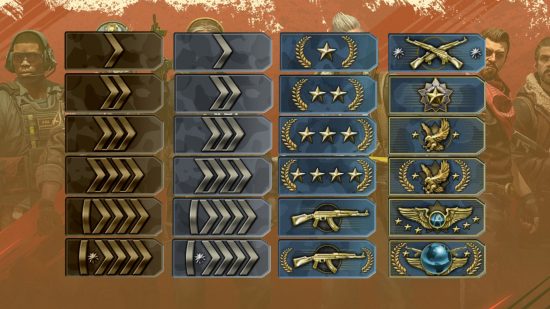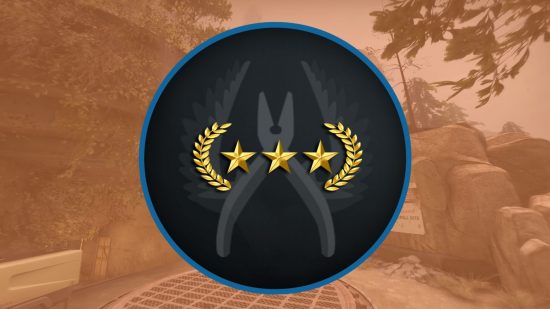Like so much else in Valve’s peerless team-based shooter, CS:GO Ranking It’s hard to understand when you start. There aren’t enough in-game explanations to help you understand how to get started with the CSGO leaderboards. It doesn’t help that patches take much longer than other competitive FPS games like Rainbow Six Siege and Overwatch.
CSGO continues to grow and now has over 1.4 million concurrent players during peak hours. This means that a lot of new gamers are learning the basics and trying to adjust to one of the best PC games of all time. However, with 18 CSGO ranks and no progress bars, it can be difficult to rank up. So we thought you might lend a hand in the unforgiving multiplayer – here’s a breakdown of the CSGO ranking system.
How do CSGO leaderboards work?
CSGO is already ten years old, but no one has been able to solve the mystery of the ranking system. There are a few things we know for sure, thanks to ranking trends and a mistake made by a longtime Valve employee in 2015.
CSGO uses the Glicko-2 system to determine the actual rank of players. Unlike the ELO system, which considers round mismatch among many other factors, Glicko-2 only cares about volatility and rating spreads. Valve modified the Glicko-2 system for its shooter, but the exact mods are unknown. But based on the Glicko-2 information available online, we have come to the conclusion of how the CSGO ranking system works in 2023.
The CSGO ranking system assigns a numerical rank to a hidden MMR (Matchmaking Rating). He is always looking for variations and spikes in your performance. Let’s say your assigned MMR is 1500-2500. No matter how many games you win, the system won’t release your allotted MMR until you make something out of the box. The higher your DR (Rank Volatility) is, the more likely you are to rank up.
So if you play around 20 games a day, the CSGO ranking system will have more accurate data to determine your ranking. If you continue to work through your skill cycle, the system won’t work as hard to rank you out because it has already determined that you are, say, silver at best.
Conversely, if you have a volatile track record, the system will notice high volatility, which means it won’t be able to decide exactly where to put you. Ultimately, this leads to greater possibilities for scaling. Players can also use this inferred information to take more breaks when the rating doesn’t change. Sometimes you can let your range expire and then come back with a surprise to increase your variance.

What are CSGO leaderboards?
The 18 CSGO ranks are divided into six tiers: Silver, Gold Nova, Guardian, Eagle, SMFC, and Global Elite. Silver I is the lowest rank you can get in CSGO, while the Global Elite rank is reserved for the best competitive Counter-Strike players.
Below are all the CSGO leaderboards in order from lowest to highest:
- money i
- Silver II
- Silver III
- Silver IV
- Elite Silver
- Silver Elite Master
- Golden Nova I
- Golden Nova II
- Golden Nova III
- Nova Gold Master
- Master Guardian I
- Master Guardian II
- Elite Guardian Master
- Outstanding Guardian Master
- legendary eagle
- Legendary Eagle Master
- Grand Master First Class
- world elite
As you can see, the biggest rank groups are Silver and Gold, which means you need to be very talented to reach higher levels like Master Guardian and Legendary Eagle. Players will also experience a significant change to the metagame and competition once they reach Silver and Gold levels.
CSGO Rankings Breakdown
Do you want to know who you are playing against in CSGO? Well, mainly Gold Novas. In 2023, approximately 34.68% of players are Gold Nova and 31.93% are Silver.
The lower ranks of CSGO are filled with overly competitive players, so most people get stuck on the lower ladder. It also means a great reward. If you manage to crack the silver rows, you’ll end up part of the crème de la crème; 0.75% of the world elite.
Here’s the full breakdown of CSGO rankings:
- Silver I: 3.9%
- Silver II: 4.23%
- Silver III: 4.37%
- Silver IV: 5.21%
- Elite Silver: 6.44%
- Silver Elite Master: 7.78
- Golden Nova I: 8.76%
- Golden Nova II: 8.79%
- Golden Nova III: 9.05%
- Master Gold Nova: 8.08%
- Master Guardian I: 7.55%
- Master Guardian II: 6.61%
- Elite Guardian Master: 5.24%
- Outstanding Guardian Master: 4.15%
- Legendary Eagle: 3.25%
- Legendary Eagle Master: 3.2%
- High Master First Class: 2.64%
- World elite: 0.75%
How to get ranked in CSGO
To earn CSGO ranks, you must first reach the second level by playing one of the standard game modes: Deathmatch, Demolition, Arms Race, and Casual. Once you reach the second level, you will be able to access ranked matches. You will need to win ten matches to be ranked in CSGO and even though you won’t be ranked, you will be thrown into games with a wide range of skill levels, very intimidating but essential for a free PC game to determine what rank you are. belong to
Even if you win the initial ten matches without fail, the highest starting rank you can get is Legendary Eagle Master. It’s also worth noting that you can only get two kills per day to earn your rank; this is to deter smurfs and pirates. Once you’ve won those first ten matches, you’ll receive your CSGO Ranking, which you can see to the right of your username when viewing the Match Dashboard.

Is Gold Nova ranked well in CSGO?
The busiest tier on the CSGO leaderboards is Gold Nova, with the average player ranked Gold Nova II, but it’s definitely not the easiest badge, especially if you’re a green CSGO player.
Nova’s abilities vary, but they tend to have a basic understanding of advanced CSGO components such as recoil and spray patterns, not to mention popular smoke and stun grenade placements. As such, new players will most likely find themselves in one of the silver ranks, defined by more smurfs and new players with a fundamental understanding of FPS gameplay, maps, weapons, and economics.
Master Guardian gives CSGO players a complete understanding of the game and its many gameplay and tactical nuances. A rank above this, such as Supreme Master First Class, is all about cultivating this skill to perfection.
How to rank in CSGO
There aren’t enough races for first place in CSGO. Wins matter first and foremost in the CSGO matchmaking system, which is based on chess rating systems like Elo and Glicko-2.
Wins are the fastest and best way to climb the CSGO leaderboards, though you can mitigate the rank drop somewhat by maintaining a high K/D ratio for World Elite picks. It also means avoiding trolls and headaches, which is always a positive.
The MMR group plays a crucial role in your ranking journey. If you play against a team with a higher MMR than you and win, your numerical value will increase much more than if you won the match against the opponent you are meant to defeat, and vice versa.
The system is more complex and includes indicators of the frequency and consistency of your game. Huge game sessions might seem like a great way to rank up, but for each consecutive game, the number of points scored or lost decreases. So playing one or two games a day, every day for a week, costs more than squeezing all those games into one horrible game session. It’s also probably much better for you.
Many players complain about not ranking up after a big winning streak, but the reason may simply be that the last few wins in the streak were worth much less than the first two or three wins.
If you need some extra help improving your CSGO ranking, our CSGO guide is here to help. CSGO has been the king of FPS for over a decade since its release, so be sure to check out the latest Counter-Strike 2 release date news if you’re looking forward to the sequel.
Source : PC Gamesn

